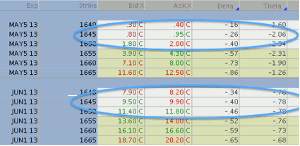The hallmark of a true professional trader is the ability to use different trade structures to exploit opportunities that the market presents, and here Greg Loehr of OptionsBuzz.com outlines how he made lemonade from lemons.
You've heard it said that you can make money in options when you're wrong. That's true. And not only is it true, there are many ways of doing it. Here's a look at just one of them.
In my live trading session on May 8, I added an SPX calendar to the model portfolio (+82% over the past one year) by buying the June 1630 puts and selling the weekly 1630 puts. The net cost of the trade was $22.00.
By May 22, the index had zoomed 57 points higher than the strike, and even the most novice of calendar traders will know that's not good for the trade.
But by initially creating the trade:
1. With a good balance of weekly expirations versus going out too far in time with the long option, and
2. Optimizing every adjustment
...this trade is now a 32% winner. That's in less than a month. God bless the weekly options.
With regard to rolling out the short option in a calendar from week to week, you need to maximize the value of your roll each week. Watch and compare the actual time value left in the short option to the theta of the option in the next week. The theta value given by your broker's platform for the short option may be incorrect, and if you wait until just before expiration to roll out, then the longer-term option may have actually decayed more.
Here's an example to illustrate the point:

AAPL options chain showing minis
Click to Enlarge
Here's a look at the SPX option chain around 11:00am ET on May 31 with the May5 weekly options expiring that day. The theta of the May5 1645 put is listed at $2.06. But an option that's worth about $0.88 (mid-point of bid/ask) can't possibly decay by $2.06, so what's up? Unless you have an amazingly sophisticated modeling program that constantly "decays" the greeks as time passes, then the greek numbers you're looking at are "beginning of day" values.
The theta for the June1 1645 put is listed at $0.78. It's not perfect, but it's much more accurate. Assuming now that the market doesn't move, the shorter-term option is going to decay $0.88 and go to zero. The longer-term option is going to decay about $0.78 today, but it's also going to decay for the better part of Saturday and Sunday, as well.
If you wait until near the end of the day to collect "all of the decay" on the shorter-term option, you're probably leaving a lot of money on the table by not rolling out to the next week and shorting an option with more theta. And I mean, a lot of money. Finding the right time to roll is part art and part science, just like everything in trading.
As a very important side note, I also reduced the risk in the trade down to $0.50 from the original $22.00; and there's still plenty of time to work with this trade further.
By Greg Loehr of OptionsBuzz.com





















